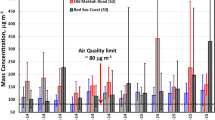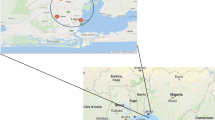Abstract
This paper describes concentration amounts of arsenic (As), particulate mercury (Hg), nickel (Ni) and lead (Pb) in PM10 and PM2.5, collected since 1993 by the Technological and Nuclear Institute (ITN) at different locations in mainland Portugal, featuring urban, industrial and rural environments, and a control as well. Most results were obtained in the vicinity of coal- and oil-fired power plants. Airborne mass concentrations were determined by gravimetry. As and Hg concentrations were obtained through instrumental neutron activation analysis (INAA), and Ni and Pb concentrations through proton-induced X-ray emission (PIXE). Comparison with the EU (European Union) and the US EPA (United States Environmental Protection Agency) directives for Ambient Air has been carried out, even though the sampling protocols herein – set within the framework of ITN's R&D projects and/or monitoring contracts – were not consistent with the former regulations. Taking this into account, 1) the EU daily limit for PM10 was exceeded a few times in all sites except the control, even if the number of times was still inferior to the allowed one; 2) the EU annual mean for PM10 was exceeded at one site; 3) the EPA daily limit for PM2.5 was exceeded one time at three sites; 4) the EPA annual mean for PM2.5 was exceeded at most sites; 5) the inner-Lisboa site approached or exceeded the legislated PMs; 6) Pb levels stayed far below the EU limit value; and 7) concentrations of As, Ni and Hg were also far less than the reference values adopted by EU. In every location, Ni appeared more concentrated in PM2.5 than in coarser particles, and its levels were not that different from site to site, excluding the control. The highest As and Hg concentrations were found in the neighbourhood of the coal-fired, utility power plants. The results may be viewed as a “worst-case scenario” of atmospheric pollution, since they have been obtained in busy urban-industrial areas and/or near major power-generation and waste-incineration facilities.
Similar content being viewed by others
References
Almeida, S. M., Freitas, M. C., Reis, M. A. and Pio, C. A.: 2003, ‘Quality assessment on airborne particulate matter of k0-INAA’, J. Radioanal. Nucl. Chem. 257, 609–613.
Almeida, S. M., Pio, C. A., Freitas, M. C., Reis, M. A. and Trancoso, M. A.: 2004, ‘Source apportionment of fine and coarse particulate matter in a suburban area at the western European coast’, Atmos. Environ. (in press).
Almeida, S. M.: 2004, Composition and Sources of Atmospheric Aerosol in an Urban/Industrial Region. Ph.D. thesis. University of Aveiro, Portugal (in Portuguese).
Alves, L. C., Reis, M. A. and Freitas, M. C.: 1998a, ‘Air particulate matter characterisation of a rural area in Portugal’, Nucl. Instrum. Meth. Phys. Res. B 136–138, 941–947.
Alves, L. C., Reis, M. A., Freitas, M. C. and Gouveia, M. A.: 1998b, ‘Elemental analysis of particulate matter and source identification in Lisbon’, X-Ray Spectrom. 27, 313–320.
Costa, C. J., Freitas, M. C., Reis, M. A., Marques, A. P. and Almeida, S. M.: 2000, ‘Elemental Characterisation of Aerosols in Setúbal Peninsula from 1994 to 1998’, in: Proceedings of the 15th International Clean Air and Environment Conference, Sydney, November 26–30, 2000, Sydney, Australia, Vol. 2, CASANZ Mitcham Vic, Australia.
Dockery, D. W. and Pope, C. A.: 1994, ‘Acute respiratory effects of particulate air pollution’, Annu. Rev. Publ. Health 15, 107–132.
Dockery, D. W., Pope, C. A., Xu, X., Spengler, J. D., Ware, J. H., Fay, M. E., Ferris, B. G. and Speizer, F. E.: 1993, ‘An association between air pollution and mortality in six U.S. cities’, New Engl. J. Med. 329, 1753–1759.
Dreher, K. L., Jaskot, R. H., Lehmann, J. R., Richards, J. H., McGee, J. K., Ghio, A. J. and Costa, D. L.: 1997, ‘Soluble transition metals mediate residual oil fly ash induced acute lung injury’, J. Toxicol. Env. Health A 50, 285–305.
European Communities: 2001, Ambient Air Pollution by Mercury (Hg). Position Paper, Office for Official Publications of the European Communities, Luxembourg.
Fairley, D.: 1990, ‘The relationship of daily mortality to suspended particulates in Santa Clara County, 1980–1986’, Environ. Health Persp. 89, 159–168.
Farinha, M. M., Freitas, M. C., Almeida, S. M. and Reis, M. A.: 2001, ‘Some improvements on air particulate matter analysis by INAA’, Radiat. Phys. Chem. 61, 659–661.
Freitas, M. C. and Martinho, E.: 1989, ‘Neutron activation analysis of reference materials by the k0-standardization and relative methods’, Anal. Chim. Acta 219, 317–322.
Freitas, M. C., Almeida, S. M., Reis, M. A. and Oliveira, O. R.: 2003a, ‘Monitoring trace elements by nuclear techniques in PM10 and PM2.5’, Nucl. Instrum. Meth. Phys. Res. A 505, 425–429.
Freitas, M. C., Almeida, S. M., Reis, M. A. and Ventura, M. G.: 2004, ‘Neutron activation analysis: Still a reference method for air particulate matter measurements’, J. Radioanal. Nucl. Chem. 262, 235–239.
Freitas, M. C., Farinha, M. M., Ventura, M. G., Almeida, S. M., Reis, M. A. and Pacheco, A. M. G.: 2005, ‘Atmospheric selenium in an industrialized area of Portugal’, J. Radioanal. Nucl. Chem. 263, 711–719.
Freitas, M. C., Reis, M. A. and Pacheco, A. M. G.: 2003b, ‘Recent Trends in Atmospheric Lead Levels at an Urban-industrial District of Metropolitan Lisbon, Portugal, through PIXE Analysis of Air-particulate Matter’, in: J. L. Duggan and I. L. Morgan (eds), Application of Accelerators in Research and Industry – AIP CP680, American Institute of Physics, Melville NY, USA, pp. 456–459.
Freitas, M. C., Reis, M. A., Almeida, S. M., Farinha, M. M., Oliveira, O. R. and Pacheco, A. M. G.: 2002, ‘PM10 and PM2.5 measurements in Portugal’, T. Am. Nucl. Soc. 87, 459–460.
Freitas, M. C., Reis, M. A., Alves, L. C. and Wolterbeek, H. Th.: 2000, ‘Nuclear Analytical Techniques in Atmospheric Trace Element Studies in Portugal’, in: B. Markert and K. Friese (eds), Trace Elements – Their Distribution and Effects in the Environment, Elsevier Science Ltd, Oxford, U.K., pp. 187–213.
Hopke, P. K., Xie, Y., Raunemaa, T., Biegalski, S., Landsberger, S., Maenhaut, W., Artaxo, P. and Cohen, D.: 1997, ‘Characterization of the Gent stacked filter unit PM10 sampler’, Aerosol Sci. Tech. 27, 726–735.
Levy, J. I., Hammitt, J. K. and Spengler, J. D.: 2000, ‘Estimating the mortality impacts of particulate matter: What can be learned from between study variability?’, Environ. Health Persp. 108, 109–117.
Maenhaut, W., François, F. and Cafmeyer, J.: 1994, ‘The “Gent” Stacked Filter Unit (SFU) Sampler for the Collection of Aerosols in Two Size Fractions: Description and Instructions for Installation and Use’, in: Applied Research on Air Pollution using Nuclear-Related Analytical Techniques – IAEA NAHRES-19, International Atomic Energy Agency, Vienna, Austria, pp. 249–263.
Mar, T. F., Norris, G. A., Koenig, J. Q. and Larson, T. V.: 2000, ‘Associations between air pollution and mortality in Phoenix, 1995–1997’, Environ. Health Persp. 108, 347–353.
Monteiro, L. R., Costa, V., Furness, R. W. and Santos, R. S.: 1996, ‘Mercury concentrations in prey fish indicate enhanced bioaccumulation in mesopelagic environments’, Mar. Ecol. Prog. Ser. 141, 21–25.
Nriagu, J. O.: 1989, ‘Natural versus Anthropogenic Emissions of Trace Metals to the Atmosphere’, in: J. M. Pacyna and B. Ottar (eds), Control and Fate of Atmospheric Trace Metals, Kluwer Academic Publishers, Dordrecht, The Netherlands, pp. 3–13.
Oberdörster, G, Gelein, R.M., Ferin, J. and Weiss, B.: 1995, ‘Association of particulate air pollution and acute mortality: Involvement of ultrafine particles’, Inhal. Toxicol. 7, 111–124.
Ozkaynak, H. and Thurston, G. D.: 1987, ‘Associations between 1980 U.S. mortality rates and alternative measures of airborne particle concentration’, Risk Anal. 7, 449–461.
Pacheco, A. M. G., Freitas, M. C. and Ventura, M. G.: 2004, ‘A nonparametric assessment of the relative output of INAA and PIXE on joint determinands in environmental samples (atmospheric biomonitors)’, Nucl. Instrum. Meth. Phys. Res. B 222, 587–592.
Pope, C. A., Hill, R. W. and Villegas, G. M.: 1999, ‘Particulate air pollution and daily mortality on Utah's Wasatch Front’, Environ. Health Persp. 107, 567–573.
Pope, C. A., Schwartz, J. and Ransom, M. R.: 1992, ‘Daily mortality and PM10 pollution in Utah Valley’, Arch. Environ. Health 47, 211–217.
Reis, M. A., Alves, L. C. and Jesus, A. P.: 1996, ‘Matrix effects correction for quantitative TTPIXE analysis’, Nucl. Instrum. Meth. Phys. Res. B 109–110, 134–138.
Reis, M. A.: 2001, ‘Biomonitoring and Assessment of Atmospheric Trace Elements in Portugal. Methods, Response Modelling and Analytical Techniques’, PhD Thesis, Delft University of Technology, Delft, The Netherlands.
Schlesinger, R. B.: 1995, ‘Toxicological evidence for health effects from inhaled particulate matter’, Inhal. Toxicol. 7, 99–109.
Schwartz, J.: 1993, ‘Air pollution and daily mortality in Birmingham, Alabama’, Am. J. Epidemiol. 137, 1136–1147.
Schwartz, J.: 1994, ‘What are people dying of on high air pollution days’, Environ. Res. 64, 26–35.
Swain, E. B., Engstrom, D. R., Brigham, M. E., Henning, T. A. and Brezonik, P. L.: 1992, ‘Increasing rates of atmospheric mercury deposition in midcontinental North America’, Science 257, 784–787.
Vincent, J. H.: 1999, ‘Sampling Criteria for the Inhalable Fraction’, in: J. H. Vincent (ed), Particle Size-Selective Sampling for Particulate Air Contaminants, ACGIH®, Cincinnati OH, USA, pp. 51–72.
Wordley, J., Walters, S. and Ayres, J. G.: 1997, ‘Short term variations in hospital admissions and mortality and particulate air pollution’, Occup. Environ. Med. 54, 108–116.
Author information
Authors and Affiliations
Corresponding author
Rights and permissions
About this article
Cite this article
Freitas, M.C., Farinha, M.M., Ventura, M.G. et al. Gravimetric and Chemical Features of Airborne PM10 AND PM2.5 in Mainland Portugal. Environ Monit Assess 109, 81–95 (2005). https://doi.org/10.1007/s10661-005-5841-9
Received:
Accepted:
Issue Date:
DOI: https://doi.org/10.1007/s10661-005-5841-9




